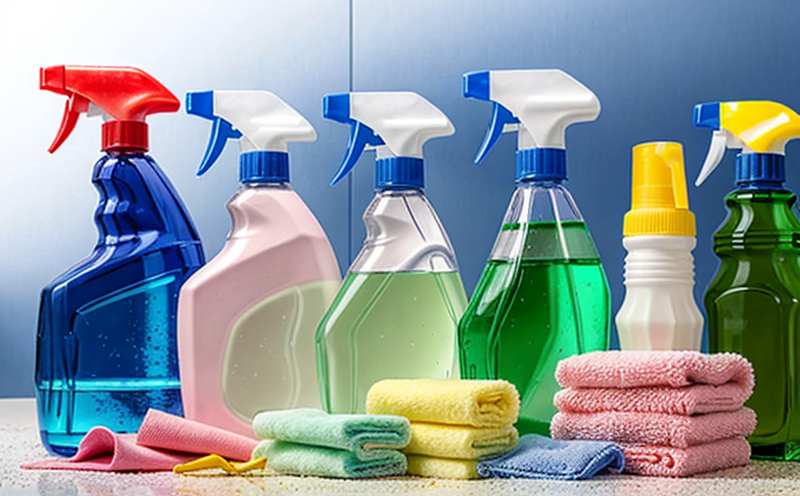Antiviral Activity Testing of Cleaning Agents
The antiviral activity testing of cleaning agents is a critical component in ensuring consumer safety and product efficacy, particularly in sectors such as healthcare, hospitality, and food service. This test evaluates the ability of a disinfectant or cleaner to deactivate specific viruses on surfaces, which is essential for preventing the spread of infectious diseases.
Understanding antiviral activity testing involves knowing that it typically targets common pathogens like influenza A (H1N1) virus, norovirus, and adenoviruses. The methodology often adheres to international standards such as ASTM E2653-18 and ISO 14975:2018, which provide guidelines for testing the efficacy of disinfectants against specified viruses.
The process begins with selecting appropriate specimens that represent real-world usage conditions. This includes preparing samples of the cleaning agent according to standard protocols, ensuring they are diluted and applied as per manufacturer instructions. After application, the test specimen is exposed to known viral cultures for a defined incubation period. The effectiveness is then determined by quantifying residual virus after treatment.
Instrumentation plays a crucial role in this testing process. Automated systems capable of precise dosing and controlled exposure environments are frequently used. Spectrofluorometric analysis or other molecular detection methods might be employed to measure viral load before and after the cleaning agent has been applied. This ensures accurate quantification, which is vital for meeting regulatory requirements.
It’s important to note that not all viruses behave similarly under these conditions; factors such as temperature, humidity, and surface material can influence results significantly. Therefore, thorough validation studies must be conducted using multiple virus types to ensure comprehensive coverage. Additionally, the testing should encompass various concentrations of the cleaning agent since effectiveness may vary depending on dilution.
The outcome of antiviral activity tests is typically reported in terms of a kill claim or reduction factor (log reduction). A log reduction value indicates how many times more effective the disinfectant is compared to not using it at all. For instance, achieving a 4-log reduction means reducing viral count by over 99.99%. Meeting these stringent standards demonstrates compliance with regulatory bodies like EPA (Environmental Protection Agency), FDA (Food and Drug Administration), or Health Canada.
- Adherence to international standards ensures consistency across different markets.
- Proper specimen preparation is key to achieving reliable results.
- Instrumentation must be calibrated regularly to maintain accuracy.
- Multiple virus types should be tested for comprehensive validation.
Quality and Reliability Assurance
The reliability of antiviral activity testing is paramount to maintaining trust in the products being tested. Quality assurance measures include rigorous validation studies using multiple virus types, ensuring that the test results are both reproducible and accurate. Regular calibration of instrumentation guarantees consistent performance over time.
Standard operating procedures (SOPs) are essential for consistency across different batches or facilities. Compliance with international standards like ASTM E2653-18 and ISO 14975:2018 ensures that the testing process is not only reliable but also internationally recognized. Regular audits and internal quality checks further reinforce these measures.
Adherence to these protocols helps ensure that manufacturers can consistently produce effective cleaning agents, meeting both regulatory requirements and market expectations. By prioritizing quality and reliability in every step of the testing process, we uphold the highest standards for consumer safety and product efficacy.
International Acceptance and Recognition
The acceptance and recognition of antiviral activity testing are critical factors that contribute to a product's marketability. Adherence to international standards such as ASTM E2653-18 and ISO 14975:2018 ensures that the results are accepted globally, which is beneficial for companies operating in multiple countries.
Products that pass these tests gain credibility with regulatory bodies like EPA (Environmental Protection Agency), FDA (Food and Drug Administration), or Health Canada. This compliance not only facilitates easier market entry but also enhances brand reputation by demonstrating a commitment to safety and efficacy.
The recognition of such testing also helps in building trust among consumers, healthcare providers, and other stakeholders. It reassures them that the products meet stringent hygiene standards, thereby fostering confidence in purchasing decisions. In an increasingly interconnected world, this international acceptance is crucial for expanding markets and maintaining competitive advantage.
Competitive Advantage and Market Impact
The ability to demonstrate robust antiviral activity testing provides a significant competitive edge in the market. Consumers increasingly demand products that offer not only cleaning effectiveness but also safety against infectious diseases, especially in sectors like healthcare, hospitality, and food service.
Products that excel in antiviral activity testing are more likely to gain customer preference due to their perceived higher efficacy and reliability. This can lead to increased market share and brand loyalty as consumers trust the product's ability to protect them from harmful pathogens.
The recognition of these tests by key regulatory bodies also opens doors for broader adoption across various industries, potentially leading to new business opportunities. Additionally, it enhances a company’s reputation within the industry, positioning it as a leader in hygiene and safety standards.





